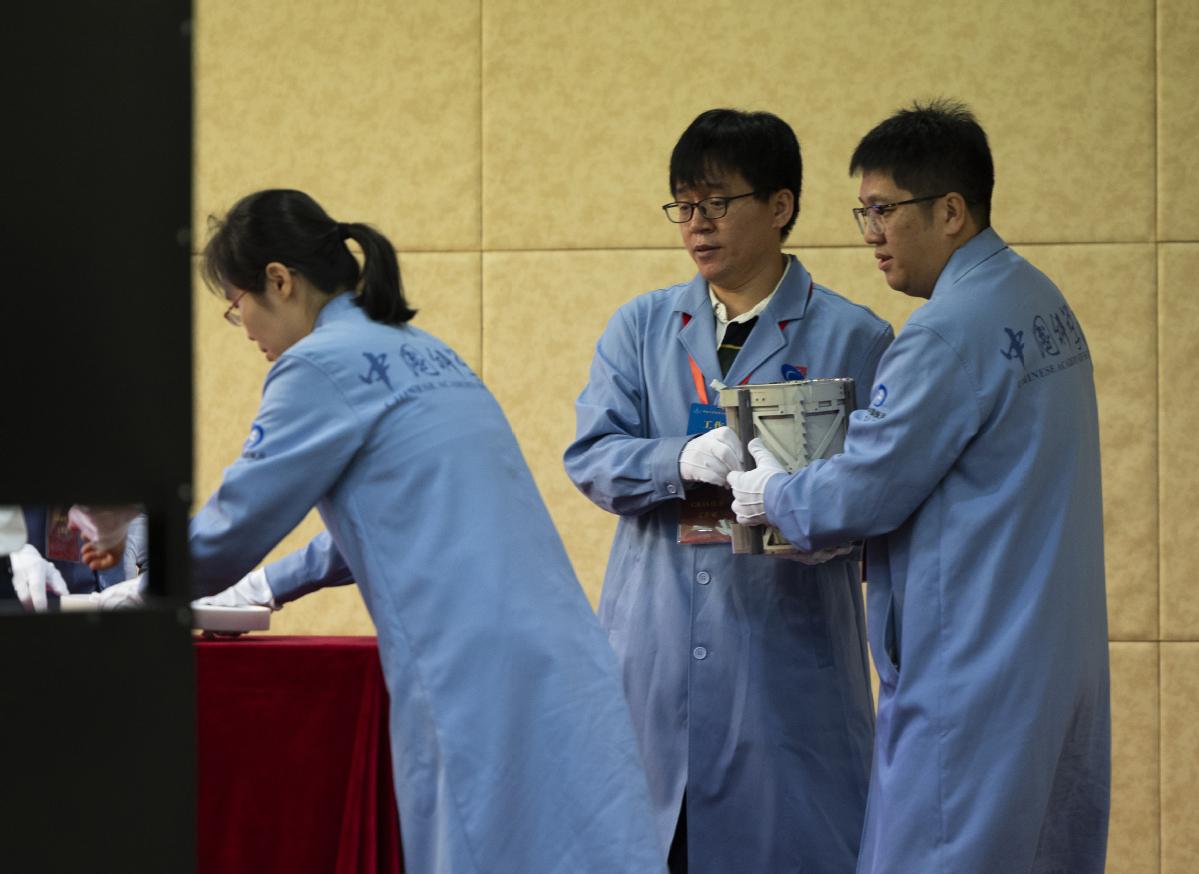
 0 Comment(s)
0 Comment(s) Print
Print E-mail China Daily, June 29, 2024
E-mail China Daily, June 29, 2024
The China National Space Administration hands over a total of 1,935.3 grams of lunar samples retrieved by China's Chang'e 6 robotic probe from the moon's far side to scientists on Friday. The samples will be transported to a laboratory in Beijing, where the first materials recovered from the lunar far side will be stored and initially processed, according to the space administration. Jin Liwang/Xinhua
A total of 1,935.3 grams of lunar samples were retrieved by China's Chang'e 6 robotic probe from the moon's far side, the China National Space Administration announced on Friday morning, as the space authority handed over the scientifically invaluable substances to scientists.
The weight of the samples, the most asked question by science and space enthusiasts over the past two days, was revealed by the CNSA at a handover ceremony at its Beijing headquarters.
Placed in a special container, lunar dust was handed over at the ceremony by Zhang Kejian, head of the administration, to Ding Chibiao, vice-president of the Chinese Academy of Sciences.
The samples have been transported to a lunar sample lab in Beijing, where the substances will be stored and initially processed, said the CNSA.
The samples, the first materials recovered from the moon's far side, have unique scientific value and will further expand humans' knowledge of the moon's history and help to gear up the exploration and exploitation of lunar resources, the administration said, noting that they are a "shared treasure" of humanity.
Ge Ping, one of the senior space officials overseeing the nation's lunar programs, said after the ceremony that the samples appear to be "thicker and stickier" than those recovered from the moon's near side — which always faces Earth — and there are some"lumps" contained within.
"Next, researchers at the National Astronomical Observatories of the Chinese Academy of Sciences will unseal the container and then divide them. After preparatory work, scientists can access the samples in accordance with our lunar sample management regulation," Ge told reporters. "We expect systematic scientific analyses and studies will lead to new findings."
According to the official, the first group of lunar samples will be available for access by domestic researchers around the end of 2024.
The samples will also be accessible to foreign scientists in due course in the near future, he added.
The Chang'e 6 mission, representing the world's first samples brought from the far side of the moon back to Earth, was launched by a Long March 5 heavy-lift carrier rocket on May 3 from the Wenchang Space Launch Center in Hainan province.
The 8.35-ton spacecraft consisted of four components — an orbiter, a lander, an ascender and a reentry capsule.
After a host of complex, challenging steps, the lander touched down in the South Pole-Aitken Basin on the far side of the moon, one of the largest known impact craters in the solar system, on the morning of June 2.
The landing marked the second time a spacecraft has visited the lunar far side.
The vast region had never been reached by any spacecraft until January 2019, when the Chang'e 4 probe landed in the South Pole-Aitken Basin. The Chinese probe and its rover surveyed areas surrounding its landing site, but did not collect and bring back any samples.
The Chang'e 6 lander worked for 49 hours on the moon's far side, using a mechanical arm and a drill to collect surface and underground materials. Meanwhile, several scientific devices were activated to conduct survey and analysis assignments.
After the tasks were completed, the sample-loaded ascender lifted off from the lunar surface and reached lunar orbit to dock with the reentry capsule to transfer the samples.
In the final leg of the mission, the orbiter and the reentry capsule flew back to Earth's orbit before separating above the atmosphere.
The reentry capsule successfully touched down at its preset landing site in the Inner Mongolia autonomous region on Tuesday.
Before this mission, all lunar substances on Earth were collected from the near side of the moon through the United States' six Apollo manned landings, the former Soviet Union's three Luna robotic missions and China's Chang'e 5 unmanned mission.
Go to Forum >>0 Comment(s)